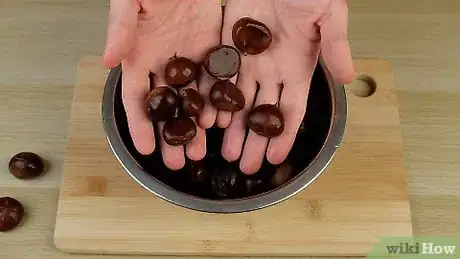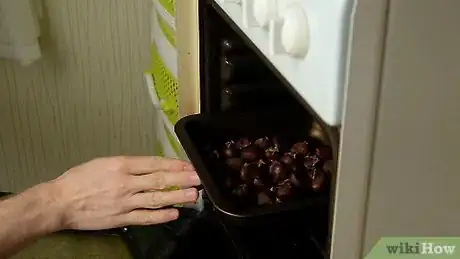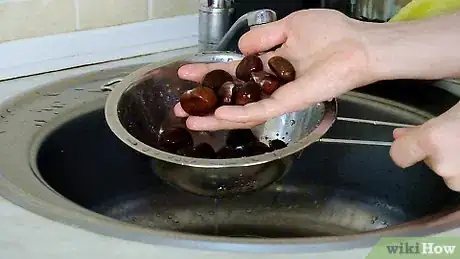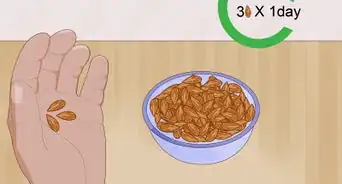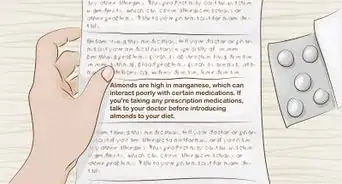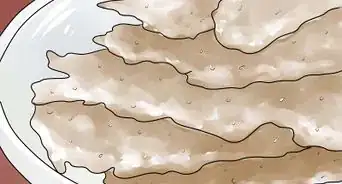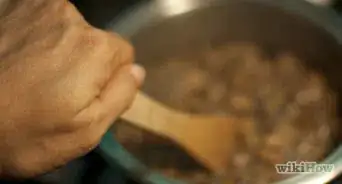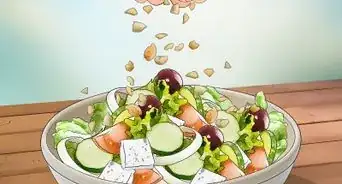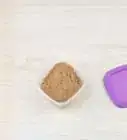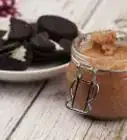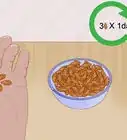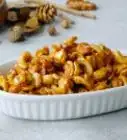This article was co-authored by wikiHow staff writer, Eric McClure. Eric McClure is an editing fellow at wikiHow where he has been editing, researching, and creating content since 2019. A former educator and poet, his work has appeared in Carcinogenic Poetry, Shot Glass Journal, Prairie Margins, and The Rusty Nail. His digital chapbook, The Internet, was also published in TL;DR Magazine. He was the winner of the Paul Carroll award for outstanding achievement in creative writing in 2014, and he was a featured reader at the Poetry Foundation’s Open Door Reading Series in 2015. Eric holds a BA in English from the University of Illinois at Chicago, and an MEd in secondary education from DePaul University.
There are 9 references cited in this article, which can be found at the bottom of the page.
The wikiHow Video Team also followed the article's instructions and verified that they work.
This article has been viewed 39,629 times.
Learn more...
Chestnuts are an excellent snack that can be prepared in under 30 minutes. The two most common methods involve using an oven or stovetop to roast the chestnuts after giving them a quick boil. Once cooked, they can be used in a variety of dishes and recipes. However you choose to prepare and use them, you need to make sure that you fully remove them from their outer shell before taking a bite.
Ingredients
Spinach Chestnut Salad
- 3 ounces (85 g) of baby spinach
- 5 ounces (140 g) of baby asparagus
- 1/2 head of radicchio lettuce
- 1/2 English cucumber
- 2 shallots
- 1 cup (240 ml) of pomegranate
- 10 cooked chestnuts
- vinaigrette dressing
Makes 4-6 servings
Chestnut Stuffing
- 3.5 ounces (99 g) of dried cranberries
- 1 onion
- 2 bacon strips
- 1.75 ounces (50 g) of butter
- 2 garlic cloves
- 16 ounces (450 g) of sausage meat
- 5 ounces (140 g) of breadcrumbs
- 2 tablespoons (30 ml) of parsley
- 0.5 tablespoons (7.4 ml) of thyme
- 5 ounces (140 g) of cooked chestnuts
- 1 medium egg
Makes 24 stuffing balls, or 8 standard servings
Italian Sausage and Chestnut Pasta
- 1 tablespoon (15 ml) of olive oil
- 1 onion
- 16 ounces (450 g) of sausage meat
- 7 ounces (200 g) of cooked chestnuts
- 2 garlic cloves
- 1 tablespoon (15 ml) of rosemary
- 1 tablespoon (15 ml) of fennel seed
- 17.5 ounces (500 g) of tomato puree
- 17.5 ounces (500 g) of pasta shells or pappardelle
Makes 6 servings
Steps
Eating Chestnuts on Their Own
-
1Check to make sure your chestnuts are safe before eating them. There are two types of chestnut—regular chestnuts and horse chestnuts. Horse chestnuts are dangerous, as they can cause nausea and vomiting if consumed. To make sure that you have an edible chestnut, inspect the shell. If the shell is prickly and rough, it's a standard chestnut. If it's smooth and easy to handle, it's probably a horse chestnut.[1]
- Another way to check for horse chestnuts is to smell them. Horse chestnuts have a bitter odor, while a regular chestnut smells sweet and nutty.
-
2Take the shell off before you eat a chestnut. If you haven't cut them with a knife before baking them, use a nutcracker to rupture the outer shell of a chestnut. Then, put it in your hand and find the opening where you cut it or split it with a nut cracker. While holding it between both hands, use your two thumbs to pull the edges of each half of the shell. Pull each shell away from one another until the shell cracks in half.
- If you're removing the shell immediately after cooking them, your chestnuts will still be hot. Hold each individual chestnut in a clean towel with both hands and then crack it, using the towel to keep your hands from getting burned.
Advertisement -
3Cook your chestnuts based on how you plan to use them. If you're going to be adding seasonings, oils, or vegetables while you're cooking chestnuts, you probably want to use a stovetop. For the classic roasted chestnut, you'll want to opt for the oven.
- You can boil your chestnuts all the way through instead of transferring them to the oven or stove, but doing so removes most of the flavor and nutrients.[2]
-
4Buy prepackaged chestnuts if you want to snack on them. You can purchase pre-cooked chestnuts if you just want a small snack without all of the hassle that comes with cooking them. They come in jars, cans, or vacuum-sealed packages, and they're available online or in grocery stores.[3]
- Always read the packaging carefully to ensure that you're about to eat pre-cooked chestnuts.
-
5Pair chestnuts with other dishes to add flavor or texture. Chestnuts work well as an ingredient or garnish. They have a soft flavor, but strong texture, which means that they are excellent for adding a bit of crunch to a dish. You can crush, grind, or dice cooked chestnuts to add them to a recipe that might work with a nutty flavor.[4]
Using Chestnuts in Recipes
-
1Create a spinach chestnut salad. In a mixing bowl, add 3 ounces (85 g) of spinach, 5 ounces (140 g) of asparagus, a ½ head of radicchio, a ½ cucumber, and 2 shallots with your vinaigrette dressing. Mix these together, and add 1 cup (240 ml) of pomegranate and 10 diced chestnuts. Continue to mix gently and serve as a main dish or simple side salad.
- You can make your own vinaigrette by whisking olive oil and white wine vinegar together in a bowl with garlic, salt, and pepper.
-
2Add chestnuts to a traditional stuffing. Fry 1 sliced onion and 2 strips of bacon together in 1 teaspoon (4.9 mL) of butter. Heat until they're fully cooked, then add your 2 garlic cloves and fry for another 1-2 minutes. Let your bacon and onion cool, then add your 5 ounces (140 g) of chopped chestnuts and additional ingredients in a glass baking dish. Bind the ingredients together with 1 beaten egg. Bake in a baking dish at 340 °F (171 °C) for 40 minutes.[5]
- You can roll stuffing into small balls and bake them that way if you're interested in spicing up the serving presentation! To do this, cup a small amount of stuffing in both hands and press it together repeatedly like you're making a snowball.[6]
-
3Mix some chestnuts into an Italian pasta. Add 1 tablespoon (15 ml) of oil to a large frying pan and heat 1 diced onion for 5 minutes. Once it starts to soften, add 16 ounces (450 g) of sausage meat and 7 ounces (200 g) of chestnuts; fry them for 10-12 minutes on high heat. Add your 2 cloves of garlic, 1 tablespoon (15 ml) of rosemary, and 1 tablespoon (15 ml) of fennel and cook for an additional 2 minutes. Add 17.5 ounces (500 g) of tomato puree and cover for 10 minutes while boiling 17.5 ounces (500 g) of pasta. Once your pasta is boiled, mix it with the sauce and top with any garnishes.[7]
- Break up the meat with a spatula or spoon while you're frying it.
- Add a glass of red wine to the sauce if you'd like it to be a little tart.
- Consider garnishing your pasta with parsley and parmesan cheese.
-
4Experiment with chestnuts in other recipes. If you want to play around with chestnuts in the kitchen, consider their ability to add texture to a recipe. Sweeter dishes that benefit from a salty profile, like brownies or ice cream, pair well with chestnuts.[8] They can also be used as an ingredient in waffles or brussels sprouts. Whether you're using it as a garnish or key ingredient, always remember that chestnuts must be cooked and peeled before you throw them in a dish.
Cooking Chestnuts on Their Own
-
1Wash your chestnuts with water to clean them. You're going to be touching the shell quite frequently during your preparation, so make sure that they're clean by rinsing them with water. Wash your hands with soap and water as well. You don't want any bad germs or bacteria hanging out on your chestnuts![9]
-
2Use a serrated knife to cut openings into each chestnut. Lay each nut on a cutting board, lengthwise. Pinch each chestnut against the cutting board using your nondominant hand. To do this, place a chestnut between your thumb and forefinger, and hold it firmly in place. Use a small serrated knife to make incisions in each chestnut.[10]
- Each incision should be the entire length of the chestnut, but only cut one side. To figure out which side needs to be cut, let the chestnut lay flat and see how it settles. Cut whichever side faces up.
- You're splitting the chestnuts to ensure that steam will escape as the nut heats. If they aren't split, the pressure can make chestnuts explode in the oven.
- The outer shells of chestnuts are slippery, so be careful while you're cutting them. Go carefully and stay focused on each cut.
-
3Boil your chestnuts before cooking them if you'd like. Add your chestnuts to a pot with cold water Turn your heat to the highest setting and wait a few minutes for the water to boil. As soon as the pot starts bubbling, turn the heat off. Use a slotted spoon to remove your chestnuts.[11]
- Boiling your chestnuts before roasting them will ensure that each entire nut gets fully coated in warm water, which will make cooking and cracking them a lot easier.
-
4Roast your chestnuts in the oven for a classic flavor. Bake your chestnuts on a sheet pan at 425 °F (218 °C) for 15-20 minutes. If your chestnuts are on the smaller side, opt for a shorter cooking time. If they're of the larger variety, you'll want to cook them a little longer. Open the oven after 5-10 minutes and give your baking pan a little shake. This will shake loose any excess water and relieve any building pressure.[12]
- Check on your chestnuts around the 13 minute mark. If they're steaming and browning, they're close to done. If they aren't, they'll probably need to cook for the full 20 minutes.
- Always remember to remove the shell before enjoying your chestnuts.
-
5Try cooking your chestnuts on the stovetop with a cast iron skillet. Heat a cast iron pan over medium heat for 3-5 minutes. Drop your chestnuts into the pan and turn them. Use a fork, spatula, or your slotted spoon to turn each chestnut so that the cuts you made are facing away from the skillet. Cook your chestnuts for 15-20 minutes while stirring them periodically.[13]
- Your chestnuts should darken in color while they cook, but if they start turning black and smoking, you're burning them and should stop immediately.
- If you're adding any oils or spices, feel free to layer them on top of your chestnuts and then shake the pan after a few minutes. Butter, olive oil, salt, and pepper all make excellent additions to chestnuts.
Things You'll Need
Using Chestnuts in Recipes
- Pasta strainer
- Spatula or wooden spoon
- Cutting board
- Knife
- Baking pan
- Mixing bowl
Cooking Chestnuts on Their Own
- Cutting board
- Serrated knife
- Slotted spoon
- Baking pan
- Towel
- Cast iron skillet or pan
- Fork, spatula, or slotted spoon
- Clear pan cover
- Plate or bowl
References
- ↑ https://www.seattletimes.com/seattle-news/before-you-roast-that-chestnut-make-sure-its-safe-to-snack-on/
- ↑ https://insearchofyummyness.com/ultimate-guide-roasting-chestnuts/
- ↑ https://www.epicurious.com/holidays-events/how-to-cook-roast-chestnuts-article
- ↑ https://www.epicurious.com/holidays-events/how-to-cook-roast-chestnuts-article
- ↑ https://www.bbcgoodfood.com/recipes/3170/chestnut-bacon-and-cranberry-stuffing
- ↑ https://www.bbcgoodfood.com/recipes/3170/chestnut-bacon-and-cranberry-stuffing
- ↑ https://www.bbcgoodfood.com/recipes/italian-sausage-chestnut-pasta
- ↑ https://commonsensehome.com/chocolate-chestnut-brownies/
- ↑ https://insearchofyummyness.com/ultimate-guide-roasting-chestnuts/
